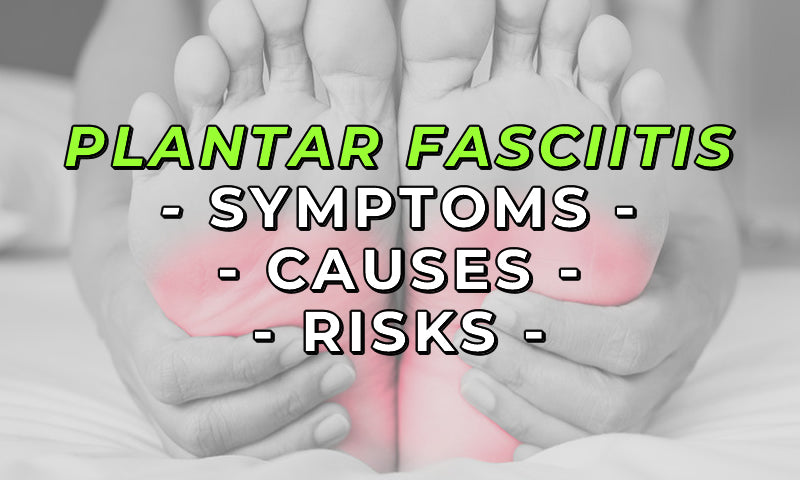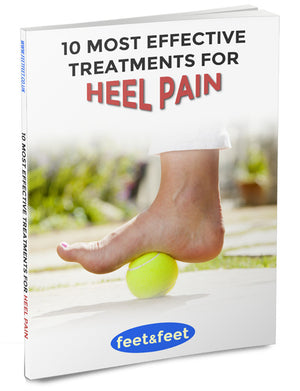Symptoms, Causes and Risks of Plantar Fasciitis

The pain from plantar fasciitis which affects the heel and arch of your foot, is at best irritating and at worst, a complete hindrance to day-to-day activities.
Find out the symptoms, causes and risks of plantar fasciitis to better understand this condition and how to prevent it from occurring.
Symptoms of Plantar Fasciitis
A defining symptom of plantar fasciitis is pain on the bottom of your foot, around the inside part of your heel and arch. The intensity of this pain can range from sharp and stinging to dull with an ache. Besides this, other tell-tale symptoms include:
- Pain in the bottom of your foot after waking up or after a period of resting your feet – after sleeping or being off your feet, your foot would have had time to rest but as soon as you start to walk about, your entire body weight is placed onto your foot again. At the same time, your arch lowers and the stretch to your plantar fascia (the tissue along the bottom of your foot that connects your heel bone to your toes) is increased so all the damaged soft tissue that was initially healing in your rest period is now being torn again as it’s stretched.
- The pain is more prominent without shoes – particularly on hard floor surfaces but the pain is more bearable with shoes on.
- Walking on tiptoes or sideways to avoid pressure to the heel – some people do this to ease the pain from your heel until they’re able to use their feet fully. Doing this is actually damaging your feet further.
If you are unable to ease the pain yourself or it doesn’t improve within 2 weeks, the NHS suggests seeing a GP for further advice.
What Causes Plantar Fasciitis?
There is no clear reason as to why and how plantar fasciitis happens but it is known to occur when your plantar fascia is strained through an activity or putting on weight.
It becomes more likely to happen with age because the fat layer under the plantar fascia starts to weaken and eventually becomes brittle in old age. Regardless of the actual cause, each cause is a ‘microtrauma’ as microscopic tears are created in the fascia.
This usually leads onto inflammation, pain, and swelling and limits what you can do. However, in some cases, there may not be any inflammation or pain and this would be known as plantar fasciosis where tissue degrades overtime. Inflammation and tissue degradation can occur simultaneously as well.
There is a possibility that the plantar fascia can snap without warning; it’s more likely to when there is increased mechanical strain such as a hard landing on your feet.
This is known as mechanical overload in the area but it may also be a combination of other factors, such as a lack of blood flow to the plantar fascia area which can affect how you move on your feet. As a result, your plantar fascia is stretched and damaged, thus starting tissue degradation.
It’s at the first stage of plantar fasciitis where treatment is most important to prevent further damage.
Risk Factors of Plantar Fasciitis
Plantar fasciitis can be avoided for some people although in some cases, it can’t be avoided because of your foot shape or a certain injury. The risk factors of plantar fasciitis that you can control include:
- Type of Footwear – Wearing the right type of shoe is important to ensure your foot is well supported for the task you are about to undertake with them on. If you wear the wrong type of shoes, you will end up straining the bottom part of your foot. Flip-flops and backless slippers are a prime example of what not to wear when walking for long periods of time.
- Footwear Size – Size is another factor where shoes must fit your feet well because being too tight or loose will aggravate your plantar fascia. Your toes will be squashed in tight shoes or trying to grip onto the insoles in loose shoes.
- Replace Old and Worn Out Footwear – Footwear with worn out heels must not be worn; doing so puts your feet at an imbalanced angle so you end up straining your plantar fascia.
- Hard Floor Surfaces – Not so easy to avoid but standing or walking on hard floor surfaces for a long period of time can increase the risk of plantar fasciitis because hard floors are inflexible; there’s no cushioning for your feet. The loading rate (pressure) is increased under your heel which also increases the likelihood of getting plantar fasciitis.
- Too Much Activity – If you suddenly take up more exercise than usual, you’ll be putting on more strain on your foot than it’s used to. The same goes if you begin a different form of exercise that may be more strenuous or take on a more physically demanding job.
- Weight Gain – An increase in weight can thin the layer of fat under the heel and reduce its flexibility which leaves your foot more exposed to plantar fasciitis. People with a high body mass index and diabetes are more at risk.
- Reduced Dorsiflexion – Dorsiflexion is the ability to raise your foot and point it upward in the direction of your shin. A reduction in this action is usually the result of tight calf muscles or hamstrings and sometimes it could be due to an inflexible body. This means extra strain on your plantar fascia as your feet attempts to walk through the use of other parts of your feet.
- Leg Injury – An injury that forces you to change the way you move around on your feet can put added strain on your plantar fascia.
The risk factors of plantar fasciitis that cannot be controlled include:
- The Arch of Your Foot – There is no definitive answer to say whether a high or low arched foot is more at risk of plantar fasciitis but people with low arched feet may find it more difficult to relieve plantar fasciitis. Similarly, people with high arched feet have a higher chance of developing plantar fasciitis under the ball of their foot.
- Your Age – The older we get, the more our body degenerates so it should come as no surprise that our health problems increase. Once we hit our forties, the fat padding under our heels will wear down more so there will be less cushioning there to absorb shocks to our feet and so the chances of plantar fasciitis increases.
Diagnosing Plantar Fasciitis
It is advised to see a foot specialist for an accurate diagnosis where foot pain lasts longer than four to five days and should not be ignored.
During your session, the foot specialist might examine your foot and ask questions such as whether you have foot pain in the morning or after a rest period.
Plantar fasciitis is usually identified through the symptoms mentioned earlier. If necessary, you may be sent for an x-ray or an ultrasound to check if there might be other contributing factors to your plantar fasciitis or if you’ve been resting your foot but you still seem to be in pain. You’ll be advised on treatment and the recovery process.
Of course, you have the option to question your diagnosis to ensure it is plantar fasciitis and not anything else.
If you have plantar fasciitis or any type of heel pain, you can read our guide on the best plantar fasciitis treatments.





Comments
Leave a comment